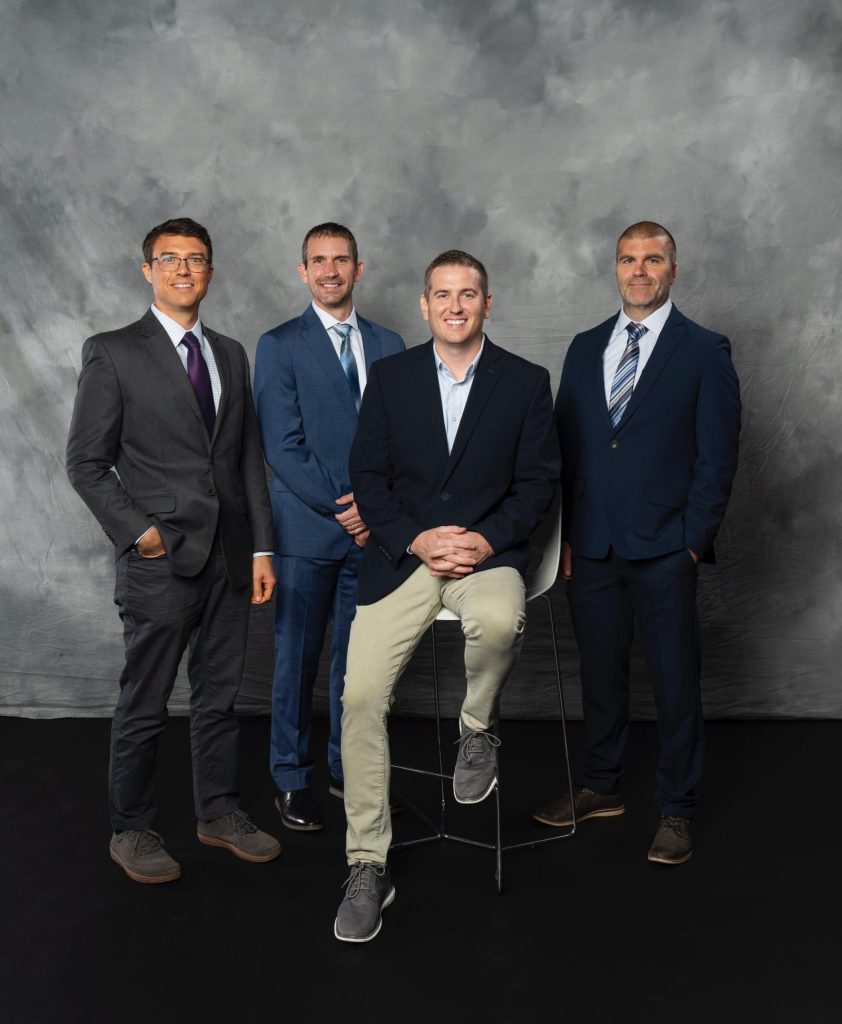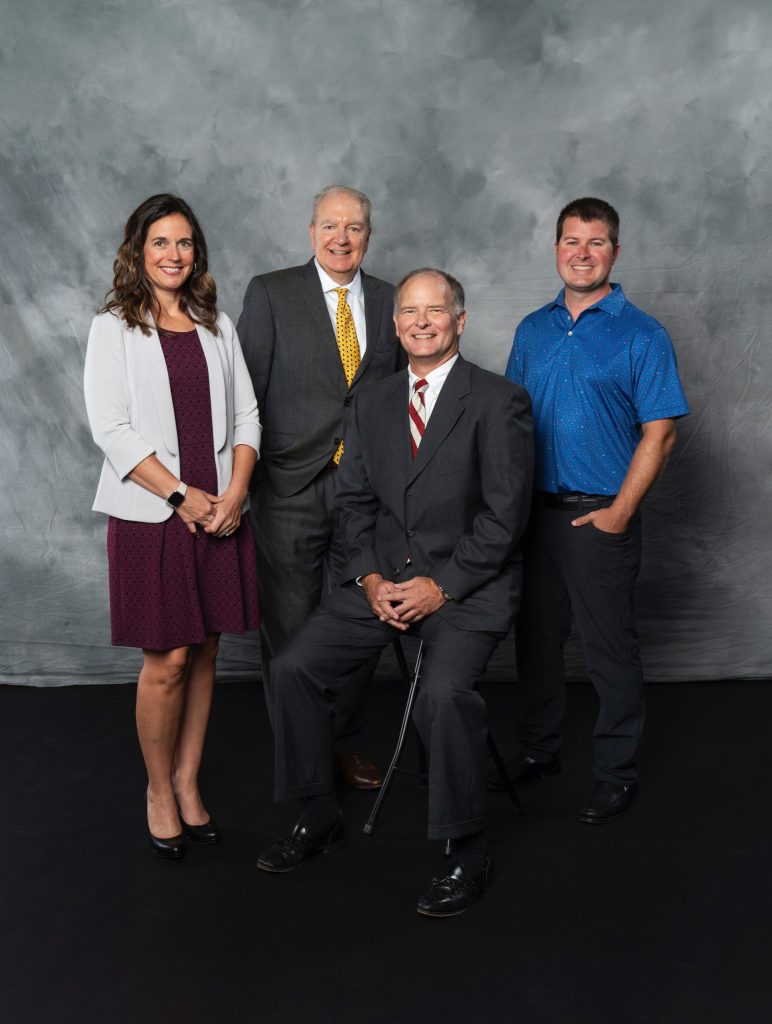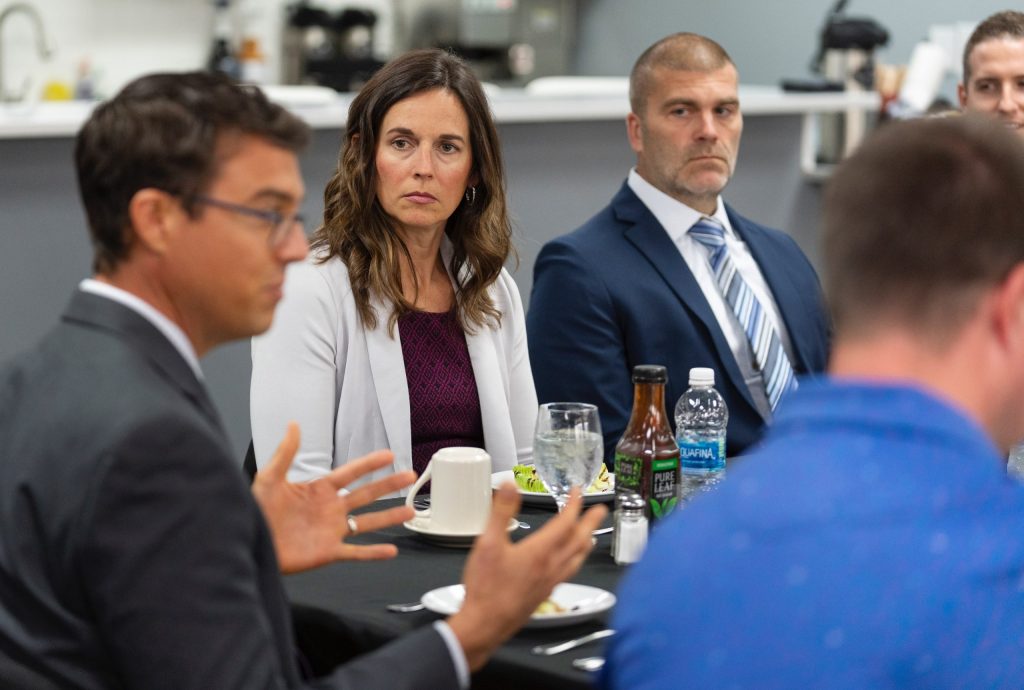Photos by L.G. Patterson
Finding affordable housing in mid-Missouri can be a real challenge. But it’s not an issue that’s unique to the Columbia area.
Across the country, communities of all different sizes are grappling with a shortage of affordable housing. And when that is lacking, it ripples out and affects other issues, including homelessness, workforce attraction and retention, and crime rates.
To discuss these issues and how they affect Columbia and Boone County, Inside Columbia Publisher Emeritus Fred Parry hosted a CEO Roundtable luncheon with eight local civic and business leaders from a variety of industries. The event was sponsored by The Broadway Hotel with the hotel’s award-winning Chef Jeff Guinn catering the meal that accompanied the conversation.
A Severe Issue
One of the largest issues facing Columbia right now is the lack of affordable housing. While the definition of affordable housing can fluctuate, Randy Cole, chief executive officer of the Columbia Housing Authority, says the federal government defines it as when a household is spending no more than 30% of their adjusted monthly gross income on total housing, which includes rent or mortgage payments and utilities.
But in Boone County, the average sale price of a home is roughly $350,000 and Cole says a household would need to make about $130,000 per year or more in order to afford that price tag. “It’s hard to get there in a lot of cases in Columbia,” he says. “It’s going to be difficult to solve the whole problem. We just need to make progress.”
While there are several reasons for the high home prices, one aspect is sheer inventory, says Jessica Kempf, sales manager with Weichert Realtors-First Tier. “There’s just no houses to sell,” she says. “That’s why prices are increasing, making it more unaffordable. It’s like this vicious snowball that continues.”
And when there’s no affordable places to live, Columbia loses its ability to retain college graduates and young professionals. “To have a healthy workforce making average wages, I think it’s impossible for somebody to afford a $400,000-plus home at this point,” she says. “Affordable housing is a severe issue in Boone County.”
When it comes to addressing the issue, Cole says he sees several barriers, including a lack of available resources, the intricacies of the development process and the fees and timetables associated with the permitting process.

An Expensive Process
Kempf says the development process needs to be made easier for those who want to build affordable housing through things like grading scales or incentives. Right now, it’s just expensive to build, she says, noting that permits can cost thousands of dollars, regardless of whether it’s a 1,000 square foot home or an 8,000 square foot home. “It’s a tough situation,” Kempf says.
Jason Gruender, manager at Liberty Family Medicine and vice president of Meyer Electric Company, agrees, noting that though his experience is more deeply rooted in the commercial side, he knows the residential realm is not much better. And when it comes to construction, he says, Columbia’s permitting and approval process is not only more expensive than other communities in Missouri, it’s more burdensome.
“It’s extremely expensive to build in this town,” Gruender says. “There’s just a lot of pain going through that process for people.”
That’s where government regulation comes in. While governmental programs can be used to ease the problem, the regulatory intricacies also can create real issues that cause developers to look elsewhere.
Ryan Krueger, managing broker at Boulevard Realty, says common sense really needs to prevail more than it has been. Several years ago, Columbia went through a lengthy process to update its zoning code, known as the Unified Development Code, which was finalized and adopted in spring 2017. Krueger says it may be time to start making some common sense allowances within the code to encourage and foster more affordable housing within city limits. “There are many lots in central Columbia where single family homes once stood and they have been demolished for one reason or another, yet new ones can’t be built due to lot size restrictions,” Krueger says.
Curtis Varns, general manager at the Networks of Mid-Missouri, which includes KMIZ, says such allowances or variances also would help with vacant commercial properties. “I look at some of the commercial entities that tried to get in the market that couldn’t get in,” Varns says. “I think about all the tax revenue we’re missing out on.”
And while Columbia does have an appeals process in place, Krueger says that, for the most part, it’s not being handled reasonably. “I think it’s time to loosen that up a bit,” he says. “Let’s use some common sense.”
A Growing Problem
Removing the barriers to affordable housing is one of the most important things the community can tackle to help break the cycle of poverty, says Boone County Presiding Commissioner Kip Kendrick, as home ownership helps create generational wealth.
And Columbia has seen an increased issue of homelessness, Gruender says, which has become a problem. It’s come to the point where it’s not uncommon to see multiple panhandlers at the same intersection, he says, which can leave a negative impression on visitors. “That’s got to be solved,” he says. “Just from an image and perception standpoint, that does not bode well for somebody coming in.”
Alex Demczak, co-founder of Streamline Books, agrees, noting that the increased visibility led him to have to explain what being homeless means to his 3-year-old child. “Having to have those conversations with a 3-year-old … that is for sure an interesting conversation,” Demczak says.
Cole, the CEO of the Columbia Housing Authority, says there’s typically about 240 chronically homeless people in the community, based on an annual count done by local agencies. Chronic homelessness refers to people who have been homeless for at least a year or repeatedly while struggling with a disabling condition such as mental illness, physical disability or a substance abuse disorder.
Often, what more people see are the panhandlers, who are unlikely to be in the chronic homeless category. As Cole points out, the chronic homeless figures do not include the more than 1,200 households that are on the Housing Authority’s wait list who are staying in a hotel or living in their car.
Kendrick says it’s important to include those cases when looking at the whole picture of homelessness. “A shelter is one portion of this,” Kendrick says. “We need to make sure that we are looking at the continuum. What comes next, whether it be a pallet home, a small home … We need to have a real honest conversation.”
Varns says despite what some may think, the number of homeless in Columbia is fairly average for the area. “It’s not extraordinarily high here,” Varns says, noting that KMIZ did some reporting on the issue earlier this year, comparing Columbia to Topeka, which had a higher homeless population. He also notes that Missouri is not near the top when it comes to statewide numbers either.
Cole says the root causes of local homelessness also are pretty much in line with other areas. “I think a lot of it is economics,” Cole says. “The people on our wait list would be considered homeless under federal law because many aren’t under a formal lease.”
It’s no secret that homeless camps exist across the city and the county, Kendrick says, even though officials continue to find them and clean them out, which is an expensive endeavor. But it’s also known that those camps simply move to another location each time that happens, he says. Instead, Kendrick says the city and county need to look at whether there is land somewhere in the area that could house a sanctioned facility or camp that contains the issue and allows for regular cleaning.
“There are no easy answers,” Kendrick says. “We know that we’ll never truly solve the issue, but we need to be working together as a community, government, non- governmental entities and businesses to try and find those pathways and take that risk.”
When it comes to the chronically homeless population, Cole says it’s a tougher population to reach and they help with removing barriers to choose a path upward. He notes that the Housing Authority has a new homeless outreach coordinator position who visits homeless camps and area service providers to try to help people fill out applications and get them started on the right path. “It’s really hard to figure out and it’s a grind,” Cole says. “We do see successes. I think there’s no quick fix and it just has to be a sustained effort knowing that it’s going to be messy.”

A Top Concern
B.J. Hunter, owner of FASTSIGNS, says he would like to see more of a focus on addressing crime in Columbia, especially violent crime. “It’s amazing the amount of crime that goes on and with weapons involved,” Hunter says. “Now everybody has a gun. I don’t understand that.”
Kempf agrees, noting that she has seen more of a rise in violent crime than Columbia used to have. “Growing up in Columbia, we’ve always experienced some level of smaller petty crimes,” she says. “It’s going to happen. We’re obviously a way bigger population than we used to be, which is a great thing, but along with that comes a chance for more serious crimes.”
Varns says crime is repeatedly marked as the No. 1 concern among KMIZ viewers and that their charge as a news station is to let people know what’s being done to address the issue. “If it’s happening, people want to know about it,” Varns says.
Kempf says crime is not specific to one area, noting that it is a community- wide issue that all of Columbia needs to address.
Krueger says there is a stigma about north Columbia, though it is easing as more businesses and amenities move into north Columbia to better facilitate future growth. “There is growth happening and that will help bring people there,” he says.
Hunter and Gruender say it also comes down to school choices. Many parents try to locate in south Columbia so their children can be in the Rock Bridge schools, Gruender says. “If you start hearing stories about moving to get them into Battle (High School), that’s when the game has changed,” Gruender says. “That’s a long play though.”
Kendrick says he is cautiously optimistic that the planned expansion of Interstate 70 will include funding for the creation of new outer roads on both the north and south side. “Those outer roads are going to lead to more economic opportunities,” Kendrick says.
RAPIDFIRE: Final Thoughts
“As an entrepreneur living in Columbia, I would love to see more co-working spaces. There is so much benefit in connecting with other entrepreneurs, and I think a lot of people would utilize them because of the rise in hybrid or remote workers since the pandemic.” — Alex Demczak, co-founder of Streamline Books
“I still feel strongly that if you get enough of the right people in the room across multiple sectors, have folks from the private sector with their expertise and then nonprofit folks and other governmental folks … to direct what they want to see happen (with development codes) and how that would work.” — Randy Cole, CEO of the Columbia Housing Authority
“Something we didn’t talk about was attracting that workforce here and keeping them here, that middle income that really can support an economy. A trade school would be huge in Columbia … something bigger and better. … We need that.” — Jessica Kempf, sales manager with Weichert Realtors- First Tier
“All too often, we avoid the difficult conversations, where difficult conversations allow you to push beyond the minutia to actually see what your long-term vision should be. All the things we’ve talked about today are critical to our future workforce development. We’re just starting to scratch the surface a little bit.” — Kip Kendrick, Boone County presiding commissioner
“We need to utilize common sense more and use the tools you already have in the toolbox. … Let’s try to help everybody as best we can, but let’s try to help the ones who are easier to help and have a better chance at moving forward. Let’s try to prioritize that so we can move the whole economy forward and the whole community forward.” — Ryan Krueger, managing broker at Boulevard Realty
“I love the outdoor opportunities here. We punch above our weight culturally in this community. Let’s just follow it out all the way. If we subscribe to the broken window theory that if we take care of our own and keep everything fixed up, good things happen. I-70 is a good example of that. I’m confident we’re going the right direction.” — Curtis Varns, general manager at the Networks of Mid-Missouri
“Workforce development — There are certain positions I have that I get applications in all the time for. There are others that never see anybody come in. We’d like to find a well-rounded approach to bringing employees in and give them the chance to develop.” — B.J. Hunter, owner of FASTSIGNS
“Near and dear to my heart is going to be affordable health care. I don’t remember the statistics, but a lot of homelessness is related to medical financial crisis. So, a lot of people are probably one major medical event away from homelessness. … How do we fix that?” — Jason Gruender, manager at Liberty Family Medicine and vice president of Meyer Electric Company







